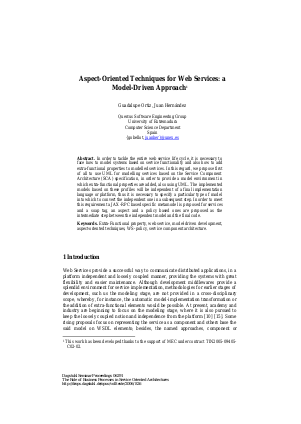Aspect-Oriented Techniques for Web Services: a Model-Driven Approach
Authors Guadalupe Ortiz, Juan Hernández
-
Part of:
Volume:
Dagstuhl Seminar Proceedings, Volume 6291
Part of: Series: Dagstuhl Seminar Proceedings (DagSemProc) - License:
 Creative Commons Attribution 4.0 International license
Creative Commons Attribution 4.0 International license
- Publication Date: 2006-11-24
File

PDF
DagSemProc.06291.8.pdf
- Filesize: 1.22 MB
- 14 pages
Document Identifiers
Subject Classification
Keywords
- Web Service
- Model Driven Development
- Aspect-Oriented Techniques
- Extra-Functional Property
- Service Component Architecture
- Ws-Policy
Metrics
- Access Statistics
-
Total Accesses (updated on a weekly basis)
0Document
0Metadata
Abstract
Web Service technologies offer a successful way for interoperability among applications, but in order to tackle the entire web service life cycle, it is necessary to face how to model systems based on service functionality and also how to add extra-functional properties to modelled services. In this regard, we propose first of all a versatile and simple UML profile based on the Service Component Architecture specification for modelling services, in order to provide a model environment in which to add extra-functional properties. Secondly, a new UML profile is proposed to model and reuse the said extra-functional properties in service models. The implemented models based on these profiles will be independent from a final implementation language or platform, thus it is necessary to specify a particular type of model to convert the independent one into in a subsequent step. In order to meet this requirement an object, an aspect and a policy based models are proposed as the intermediate step between the independent model and the final code. We acknowledge that there are tools available which convert Java models into web services' Java code, and it is not our aim to build a tool to fulfil this requirement. Regarding extra-functional properties, aspect-oriented techniques allow them to be easily modularized and reused; in this respect, properties are implemented as aspects in a totally transparent way and avoid the need to modify service code in an intrusive manner on adding extra-functional properties, improving our system maintenance. Furthermore, this way traceability between the model and the code is perfectly maintained in both directions. This work has been developed thanks to the support of CICYT under contract TIN2005-09405-C02-02.
Cite As Get BibTex
Guadalupe Ortiz and Juan Hernández. Aspect-Oriented Techniques for Web Services: a Model-Driven Approach. In The Role of Business Processes in Service Oriented Architectures. Dagstuhl Seminar Proceedings, Volume 6291, pp. 1-14, Schloss Dagstuhl – Leibniz-Zentrum für Informatik (2006)
https://doi.org/10.4230/DagSemProc.06291.8
BibTex
@InProceedings{ortiz_et_al:DagSemProc.06291.8,
author = {Ortiz, Guadalupe and Hern\'{a}ndez, Juan},
title = {{Aspect-Oriented Techniques for Web Services: a Model-Driven Approach}},
booktitle = {The Role of Business Processes in Service Oriented Architectures},
pages = {1--14},
series = {Dagstuhl Seminar Proceedings (DagSemProc)},
ISSN = {1862-4405},
year = {2006},
volume = {6291},
editor = {Frank Leymann and Wolfgang Reisig and Satish R. Thatte and Wil van der Aalst},
publisher = {Schloss Dagstuhl -- Leibniz-Zentrum f{\"u}r Informatik},
address = {Dagstuhl, Germany},
URL = {https://drops.dagstuhl.de/entities/document/10.4230/DagSemProc.06291.8},
URN = {urn:nbn:de:0030-drops-8269},
doi = {10.4230/DagSemProc.06291.8},
annote = {Keywords: Web Service, Model Driven Development, Aspect-Oriented Techniques, Extra-Functional Property, Service Component Architecture, Ws-Policy}
}
